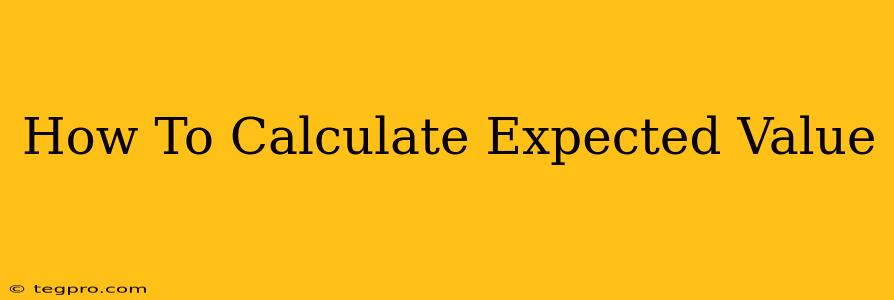Expected value (EV), also known as expected return, is a crucial concept in probability and statistics, with wide-ranging applications in finance, gambling, and decision-making. Understanding how to calculate it can significantly improve your ability to assess risk and make informed choices. This guide breaks down the process in an easy-to-understand way.
What is Expected Value?
In simple terms, expected value represents the average outcome you can expect from a given event or decision over a large number of repetitions. It's not necessarily the outcome you'll get in a single trial, but rather the average result you'd see if you repeated the experiment many times.
How to Calculate Expected Value
The formula for calculating expected value is straightforward:
EV = Σ [P(x) * x]
Where:
- EV represents the expected value.
- Σ denotes the sum (adding up all the possibilities).
- P(x) is the probability of each outcome (x).
- x represents the value of each outcome.
Let's illustrate with examples:
Example 1: A Simple Coin Toss
Imagine a coin toss where you win $1 if it's heads and lose $1 if it's tails. The probability of heads (P(heads)) is 0.5, and the probability of tails (P(tails)) is also 0.5.
- Outcome 1 (Heads): P(heads) = 0.5, x = $1
- Outcome 2 (Tails): P(tails) = 0.5, x = -$1
EV = (0.5 * $1) + (0.5 * -$1) = $0
The expected value is $0. This means, on average, you neither gain nor lose money over many coin tosses.
Example 2: A Slightly More Complex Scenario
Let's say you're playing a game where you roll a six-sided die. If you roll a 6, you win $10; otherwise, you lose $1.
- Outcome 1 (Roll a 6): P(6) = 1/6, x = $10
- Outcome 2 (Roll any other number): P(not 6) = 5/6, x = -$1
EV = (1/6 * $10) + (5/6 * -$1) = $10/6 - $5/6 = $5/6 ≈ $0.83
The expected value is approximately $0.83. This suggests that, on average, you'd expect to win about 83 cents per roll over many repetitions.
Example 3: Investment Decision
Expected value is extensively used in finance to evaluate investments. Suppose you're considering two investment options:
Investment A: 70% chance of a $1000 return, 30% chance of a $0 return. Investment B: 50% chance of a $2000 return, 50% chance of a $0 return.
Investment A: EV = (0.7 * $1000) + (0.3 * $0) = $700 Investment B: EV = (0.5 * $2000) + (0.5 * $0) = $1000
Based on expected value alone, Investment B is the better choice, offering a higher average return.
Beyond the Basics: Applications and Limitations
Expected value is a powerful tool, but it's crucial to understand its limitations:
- Risk Aversion: EV doesn't account for individual risk tolerance. Someone might prefer a smaller, certain gain over a larger but riskier potential return, even if the EV is higher for the riskier option.
- Non-linear payoffs: Expected value calculations assume a linear relationship between outcomes and their values. This might not always hold true in real-world scenarios.
- Sample Size: The accuracy of the expected value calculation depends on the accuracy of probability estimations and a sufficiently large number of trials.
Despite these limitations, understanding how to calculate expected value is a fundamental skill for making better decisions under uncertainty across various fields. Mastering this calculation empowers you to make more informed choices in finance, gambling, and everyday life.

